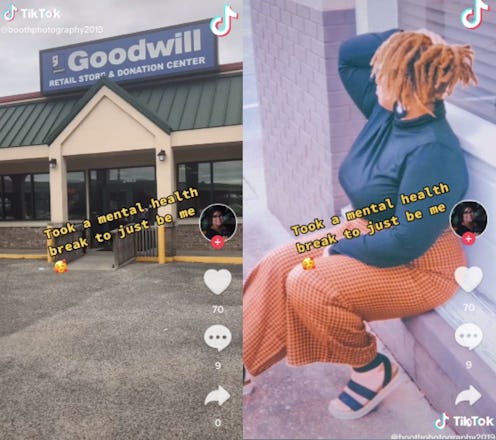Social Media
Thrifting TikTok Is Providing An Escape In Lockdown
“The sense of euphoria experienced while thrifting is real.”
“Does anybody else rely on thrifting as a therapy right now?” Sam, 24, asks TikTok from her car, post-thrift shopping session, wearing a mint green button-down that she found at Second Chance in Monterey, California. “I can’t do a FaceTime therapist; that just won’t work for me. So thrifting, finding all the cool, random, weird things, makes me happy.” Her video is flooded with comments from women who agree.
When I’m in a bad mood that no amount of 4-7-8 breathing can fix, I drag myself onto the subway and ride all the way uptown to my favorite Goodwill on New York City’s Upper East Side. I’ve found brand-new AGOLDE jeans, Marchesa workwear, and a Calvin Klein camel coat, plus polka-dotted candlesticks. But really, I just like being in there, unsure of what I’ll find. (Yes, the employees know me.)
Not that long ago, I wouldn’t have publicized the fact that most of my wardrobe is used. That attitude is changing, with millions tuning in to watch strangers sift through other strangers’ stuff on ThriftTok. People are finding the most underrated thrift stores in their area, tips on how to keep your thrift day anxiety-free, and the secondhand excitement of spotting genuine '60s-era Coca Cola merch. During a pandemic that’s adversely impacted many people's mental health, ThriftTok — a kind of vicarious, all-virtual retail therapy — is a safe outlet for the satisfying surprise of a score.
“The sense of euphoria experienced while thrifting is real,” says Montreal-based trauma therapist and clinical counselor Gabriella Evans, MA, CCC. “It’s simply the neurotransmitter dopamine being released in the brain. Dopamine is an important part of the brain’s reward system and levels are actually at their highest point when we are anticipating a potential reward, like that cute vintage dress or perfect piece of kitschy kitchenware. Hence the thrill of the hunt.”
The value of thrifting for self-care can vary for different people. Dr. Sophie Chung, MD, founder of Qunomedical, notes that while “running your hands through fabrics” is calming for some, “a person with OCD might feel a nagging urge to buy a certain item or something terrible is going to happen.”
Evans affirms that while thrifting, like retail therapy, isn't a literal treatment for depression or anxiety, it can be thought of as harm reduction — there are significantly fewer negative effects than other high-dopamine activities like drug use or gambling. ThriftTok takes that principle one step further, providing the vicarious thrill of witnessing “the thrift gods rolling through the racks” without acquiring anything yourself.
Finding inspiration in ThriftTok versus IRL retail therapy can relieve another stressor — the financial kind. When Jess, 27, was in college, her vice when she was upset was to spend money. “I would go to Sephora and spend $300 instead of buying textbooks. And I did not grow up in a situation where I could afford to do that, so I’d end up having to go to the library for the rest of the quarter every single night to use the textbooks there instead.”
“Getting myself away from that has been really important to my mental health,” she says. “It’s like my crutch was the thing that was also causing the majority of my stress. And I feel like thrifting is such a safe middle ground. It’s Nicorette for people who like to shop.”
Of course, just as Nicorette gum contains nicotine, buying $4 crocheted tank-tops is still spending money. And acquiring things you don’t need or absolutely love can be detrimental to your own long-term mental health, especially if clutter becomes a source of guilt. ThriftTok has also started discussions about the ethics of thrifting and reselling. “With all the information on there, I came to the conclusion that I don’t feel the best about buying a ton of stuff, because there are families that rely on thrift stores to support themselves," Sam says. "I tend to only come out with pieces that really resonate with me.”
In this way, secondhand shopping can be a kind of coping mechanism if you see it as an exercise in curiosity, as something to do (double-masked) while movie theaters, spas, and other kinds of self-care activities aren’t accessible. Even if you don't buy anything — or don't feel comfortable going thrifting IRL — there's plenty of #ThriftTok to keep you sated.
Experts:
Gabriella Evans, MA, CCC
Dr. Sophie Chung, MD
